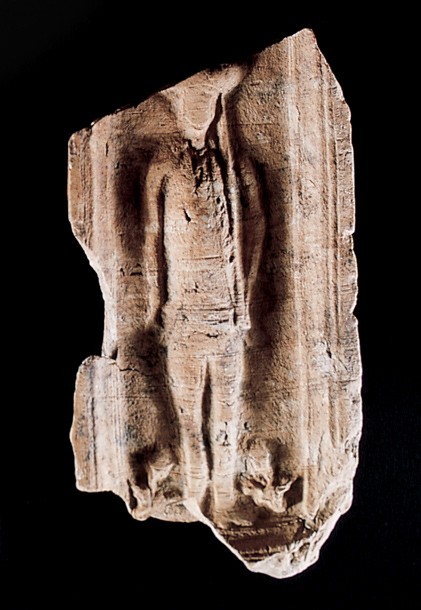
View of completed 15' x 18' excavation encompassing a five-flued kiln. Scale in feet. (All photos, Alain C. Outlaw.)

Range of wares produced at Mount Shepherd, North Carolina, 1793–1799. Biscuit fired earthenware. Left to right: storage jar, slipware plate, stove tile. Center: reed pipe bowl. Scale is in inches and centimeters.

Detail of the anthropomorphic smoking pipe illustrated in figure 2.

Detail of the soldier stove tile illustrated in figure 2.

Fragments of a mounted soldier stove tile and border. Scale is in inches and centimeters.
A backyard of 532 acres of woodlands in the rolling hills of central North Carolina—what more could two preteen brothers ask for in 1968, when the outdoors and imagination played central roles in entertainment? The explorations of Jeffery and Lee Farlow, ages eleven and nine respectively, led to their discovery of pottery fragments, bearing “silver looking stuff . . . wagon wheel designs . . . and elbow type legs” on a small upland near their home at the Mount Shepherd Methodist Camp, eight miles northwest of Asheboro.[1] When I was introduced to the site several years later, it reminded me of my 1961 visit to the caves of Lascaux, discovered by five boys in central France in 1940. There, too, the secret and unexpected finds from a remote wooded area were eventually, reluctantly, revealed to grownups.
But unlike the Lascaux caves, the finds at Mount Shepherd were visible on the surface. Ceramic sherds were discovered on top of the ground, and the remnants of stone footings for the pottery manufactory were under slight mounds of stone rubble. As well, clay pits or cellars appeared as depressions on the forest floor. Under the auspices of the North Carolina Historical Potters Exploration, Inc., created by the late Mr. and Mrs. Walter Auman of Seagrove, these topographic irregularities in the woods were excavated in 1974 and 1975, revealing the remains of a stone-walled kiln with brick-lined flues (fig. 1), brick heating stove base, workshop floor defined by a clay lens, clay extraction pits, and various stone pier and foundation traces.[2] All the major elements of the pottery manufactory, including clay extraction, clay processing, turning and molding, firing, and storage, were archaeologically investigated.[3]
Excavations of the relatively small and remote operation revealed that a surprisingly large and sophisticated range of pottery was produced at Mount Shepherd (fig. 2). Both wheel thrown and press molded objects manufactured at the site served the needs of the local market, and they included forms for food storage and serving, household heating, and leisure activities. By far, the most prolific vessel form was the undecorated, interior-glazed, utilitarian food storage jar found throughout the entire site, including the last firing of the kiln. A pit contiguous to the kiln was filled with biscuit fired dishes extensively decorated with slip-trailed geometric and floral motifs. Found elsewhere were fragmentary and complete examples of molded reed smoking pipe bowls, bearing fine, crisply detailed faces (fig. 3). Serving a functional as well as a decorative role, press molded biscuit fired stove tiles were also made at Mount Shepherd. The relief motifs include a soldier standing at attention with a musket at his left shoulder and wearing a waistcoat, coat, and tricorn hat (fig. 4).[4] Another reminder of Lascaux, a small headed, long bodied, short-legged horse decorates the surface of other stove tiles (fig. 5). In contrast to its rider who sports a long braided queue, the walking horse’s tail is close cropped. The rider is outfitted in a short tailed coat and a jockey-style hat common to those worn by mounted soldiers, or dragoons, in the period.
The discovery of the Mount Shepherd site in 1968 came on the heels of important excavations carried out by Stanley South on Moravian pottery making sites at Bethabara and Salem, North Carolina, from 1963 to 1968.[5] Although the Mount Shepherd wares closely resembled ceramics made by Gottfried Aust from 1755 to 1771, the few non-locally made artifacts recovered dated the site to circa 1775–1800. Obvious from the onset that the Mount Shepherd pottery was manufactured in the Moravian tradition, later artifact and documentary research by L. McKay Whatley divulged the link and name associated with the site. Whatley presented conclusive evidence that a former Aust apprentice, Philip Jacob Meyer (aka Jacob Meyer, Jr.) owned the land and ran the pottery between circa 1793 and 1799.[6]
It is clear from the investigations at this site that sophisticated wares in the region were not exclusively made in the principle Moravian settlements. Not only could these diverse forms be found in the hinterlands, but, like the militaristic motifs unknown in the Moravian pacifist tradition, they could take an unexpected course. This diversity points out that there is yet much to be learned about non-English pottery traditions in North America.
Alain C. Outlaw
Principal Archaeologist
Archaeological & Cultural Solutions, Inc.
Williamsburg, Virginia
<Outlaw@archaeologist.us>
<http://archaeologist.us/>
James Wicker, “Archaeologists Explore Old Pottery Site in Randolph,” The Randolph Guide (North Carolina), Wednesday, April 23, 1969.
Alain C. Outlaw, “Preliminary Excavations at the Mount Shepherd Pottery Site,” The Conference on Historic Site Archaeology Papers 9 (Columbia, S.C.: University of South Carolina, 1974), pp. 2–12.
Alain C. Outlaw, Mount Shepherd Pottery Site, National Register of Historic Places Inventory–Nomination Form (May 30, 1979).
Lowell McKay Whatley, Jr., “Moravian Tile Stoves of the American Colonial Period,” (presented to the Department of Fine Arts in Partial Fulfillment of the Requirements for the Degree of Bachelor of Arts with Honors, Harvard College, Cambridge, Mass., April 1, 1977).
John Bivins, Jr., The Moravian Potters in North Carolina (Chapel Hill, N.C.: The University of North Carolina Press, 1972). Stanley South, Historical Archaeology in Wachovia–Excavating Eighteenth-Century Bethabara and Moravian Pottery (New York: Kluwer Academic/Plenum Publishers, 1999).
L. McKay Whatley, “The Mount Shepard Pottery: Correlating Archaeology and History,” Journal of Early Southern Decorative Arts 6, no. 1 (1980): 21–57.
